
About UsThe Numismatic Bibliomania Society is a non-profit organization promoting numismatic literature. For more information please see our web site at coinbooks.org SubscriptionsThose wishing to become new E-Sylum subscribers (or wishing to Unsubscribe) can go to the following web page link MembershipThere is a membership application available on the web site Membership Application To join, print the application and return it with your check to the address printed on the application. Membership is only $15 to addresses in the U.S., $20 for First Class mail, and $25 elsewhere. For those without web access, write to: David M. Sundman, Secretary/TreasurerNumismatic Bibliomania
Society AsylumFor Asylum mailing address changes and other membership questions, contact David at this email address: dsundman@LittletonCoin.com SubmissionsTo submit items for publication in The E-Sylum, just Reply to this message, or write to the Editor at this address: whomren@coinlibrary.com
BUY THE BOOK BEFORE THE COINYou won't regret it! |
- WAYNE'S WORDS: THE E-SYLUM JULY 13, 2008
- REVIEW: TREASURE IN THE CELLAR BY LEONARD AUGSBURGER
- MORE ON ROY PENNELL'S COUNTERFEIT DETECTOR PUBLICATIONS
- LOCAL NEWSPAPER PROFILES AUTHOR KATHERINE JAEGER
- NUMISMATIC NOVEL IN THE WORKS: THE ELYMAIS COIN
- CHARLES DAVIS ON INSIGNIFICANT ADJECTIVES IN COIN CATALOGUE DESCRIPTIONS
- MORE ON THE MEDALLIC HISTORY RESEARCH OF TONY LOPEZ
- MORE LORE ON ANNIE OAKLEY
- MUSEUM/COLLECTOR DEBATE: FRANK STEWART'S FIRST U.S. MINT COLLECTION
- PETE SMITH ON LIBRARY DISASTER RECOVERY
- ARTISTS & AUTHORS ALLEY TO DEBUT AT BALTIMORE ANA CONVENTION
- ANA SETTLES LAWSUIT AGAINST FORMER EMPLOYEES
- THE DARWIN-WALLACE MEDAL
- CHINA DITCHES MAO TO PUT OLYMPICS ON NEW BANKNOTE
- WAYNE'S NUMISMATIC DIARY, JULY 13, 2008
- AUSTRALIAN COIN COLLECTION OF DR JOHN CHAPMAN TO BE SOLD
- LORD ASHCROFT'S VICTORIA CROSS COLLECTION GOES TO IMPERIAL WAR MUSEUM
- BUTTONS: THE NUMBER THREE COLLECTING HOBBY
- SURVIVALIST URGES STOCKPILING OF NICKELS
- INDIANA BANK RETURNS $1,000 BILLS TO DEPOSITOR
- DENVER COIN DROP CIRCULATES CENTURY-OLD COINS
- ULTIMATE COIN DROP: HOUSE VISITOR SPENDS COINS WORTH $500,000+
- DAVID GANZ ON REP. BROOKE'S ROLE IN THE BICENTENNIAL COIN PROGRAM
- HUB COIN BLOOPER: TYPO, OR MEHL'S ADVERTISING SECRET?
- FEATURED WEB SITE: CHALLENGE COIN ASSOCIATION
WAYNE'S WORDS: THE E-SYLUM JULY 13, 2008
 Among our recent subscribers are Ron Lerch,
courtesy of Duane Feisel, Kevin Foley, courtesy of John and Nancy Wilson,
Josh Wadsworth, courtesy of Sam Deep, Bernhard Weisser of Germany, and K.
V. Eckardt. Welcome aboard! We now have 1,162 subscribers
Among our recent subscribers are Ron Lerch,
courtesy of Duane Feisel, Kevin Foley, courtesy of John and Nancy Wilson,
Josh Wadsworth, courtesy of Sam Deep, Bernhard Weisser of Germany, and K.
V. Eckardt. Welcome aboard! We now have 1,162 subscribersThis week we open with a short review of Len Augsburger's new book, and learn more about Pennell's counterfeit detector reprints. In topics inspired by previous articles we discuss the Voltaire, 1777 Franklin, Hume and D'eon Medals and Frank Stewart's collection of items relating to the first U.S. Mint.
In the news, the ANA settles one of its lawsuits, a significant collection of Australian coinage is going up for auction, and Lord Ashcroft finds a home for his Victoria Cross collection. This week's numismatic diary covers some interesting love tokens and visits to both Baltimore, MD and Washington, D.C.
To learn about B. Max Mehl's advertising secret and tokens made to honor “hatches, matches, dispatches or snatches”, read on. Have a great week, everyone.
Wayne Homren
Numismatic Bibliomania Society
REVIEW: TREASURE IN THE CELLAR BY LEONARD AUGSBURGER
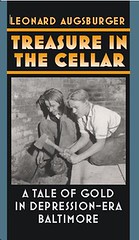 Treasure in the Cellar by Leonard
Augsburger is an interesting book with a surprising end. Augsburger did
much research about the story of over $11,000 face value in gold coins
found in the basement of a home rented by the family of one of the two
teenagers who found the gold coins. He tells the stories of the teenagers,
their families, owners and previous owners of the home in which the gold
was found, the judge and his staff, policemen, the auctioneer of the gold
and folks who purchased some of the gold as well as what was described as
a second find, but might have been part of the original find.
Treasure in the Cellar by Leonard
Augsburger is an interesting book with a surprising end. Augsburger did
much research about the story of over $11,000 face value in gold coins
found in the basement of a home rented by the family of one of the two
teenagers who found the gold coins. He tells the stories of the teenagers,
their families, owners and previous owners of the home in which the gold
was found, the judge and his staff, policemen, the auctioneer of the gold
and folks who purchased some of the gold as well as what was described as
a second find, but might have been part of the original find.
After all was said and done, with strict controls over the inventory of the find, the judge awarded the find to the two teenage boys minus various expenses including a third to their attorney as well as expenses to an auctioneer. At the time, neither the current nor the past owners of the house received anything, because none could prove that the treasure had been theirs.
We attended a program presented by the author at the Maryland Historical Society at which time the story was presented. There were relatives of some of the characters present as the program. Author Leonard Augsburger will be at the A. N. A. convention in Baltimore to talk about his book and sell copies to those interested parties.
MORE ON ROY PENNELL'S COUNTERFEIT DETECTOR PUBLICATIONS
Michael J. Sullivan writes:While the July 7th article shares some of Mr. Pennell accomplishments, I thought it would be interesting for our bibliophile community to learn a bit more about the rarities of his works. You cited the reprints of two counterfeit detectors (Gwynne & Day, 1862 and Hodges …you left the date out ….1865).
You are correct that the “pedestrian copies” were published in green cloth. But how many of our readers have the ultra-elusive copies in white cloth? My good friend Bob Cochran informed me of white cloth publications of a few SPMC books in the late 90s. It took me another decade to secure the books.
I remember white, albeit leather, was a personal favorite of Armand Champa. The leather jacket story is a romantic memory of the pinnacle of American numismatic literature collecting. While Armand, like many other mavericks in this hobby, was a controversial person, I’ll always cherish the day he called me in Cincinnati, invited me to his home, and subsequently suggested I become and NBS officer. This eventually led to my NBS Presidency during which the E-Sylum commenced thanks to the passionate efforts of Mr. Homren.
Yes – both Pennell reprints of the Gwynne & Day Descriptive Register of Genuine Bank Notes (1862) and Hodges, Edward, Hodges' American Bank Note Safeguard (1865) were also made in white cloth and are ultra elusive. They have never appeared in an auction of any of the numismatic literature dealers, but reside in my collection ex: Heritage.
LOCAL NEWSPAPER PROFILES AUTHOR KATHERINE JAEGER
Jaeger earned a Bachelor of Arts degree from Allegheny College in 1979, and spent each of her college summers working at archaeological digs in Israel. There she first heard the peculiar term numismatics, and began to view coins as archaeological dating tools and as pieces of historical record.
From 1979 to 1986 she worked in New York City as a copy editor and managing copy editor. Later, while raising a family with her husband, Tom, she switched to freelance editing. In 1999, she began writing history features for magazines such as American History and American Heritage.
The “hook” into exonumia came when she found a clipping of an 1885 newspaper interview with diesinker George H. Lovett, her great-great-grandfather. Immersed in the study of medals and tokens since then, she has authored several features for “The Numismatist” and “Coin World” and is the co-author (with Q. David Bowers) of “Whitman’s 100 Greatest American Medals and Tokens.”
To read the complete article, see: Gowen City woman’s book to be released in July (http://www.zwire.com/site/news.cfm?newsid=19831496
&BRD=2715&PAG=461&dept_id=558782&rfi=6)
NUMISMATIC NOVEL IN THE WORKS: THE ELYMAIS COIN
To read the complete article, see: An Interview with John Manhold About His New Book El Tigre (http://www.bloggernews.net/116598)
CHARLES DAVIS ON INSIGNIFICANT ADJECTIVES IN COIN CATALOGUE DESCRIPTIONS
Answer: They are just some of the hollow modifiers gleaned from the headlines of the latest Stack's catalogue. The last one is my favorite. I do not see a coin as being "important." A cure for cancer is important, but we take our selves a little to seriously to consider a coin important. Significant - yes, but not important. And notice that the word significant is missing from the above list.
So why now do I point this out when it has been going on since Kurt Krueger's nauseating 1984 ANA catalogue? An English colleague who now receives the similarly written Smythe catalogues for the first time since the company's purchase by Spink called me with both amusement and disgust in his voice. My answer was of course, "Welcome to America. We speak English here."
THE BOOK BAZARRE
MORE ON THE MEDALLIC HISTORY RESEARCH OF TONY LOPEZ
Regarding last week's item on Tony Lopez' article "Mystery Solved? Voltaire, 1777 Franklin, Hume and D'eon Medals in The MCA Advisory, Numismatic Bibliomania Society President John W. Adams writes:In our book COMITIA AMERICANA, after an extensive discussion of various theories, we describe the 1777 Franklin medal: "In the end, the secret of this medal is that it is a secret medal. If those who produced it did not want their efforts known, it is not likely that we will pick up their trail 200 years later".
... not likely unless Tony Lopez takes up the case! What makes his work even more praiseworthy, in my opinion, is that some of our finest experts told Tony that he was barking up the wrong tree in the wrong forest. Undismayed, he persevered and achieved a conclusion that is irrefutable. May Tony find many more challenges and may others be inspired to do likewise.
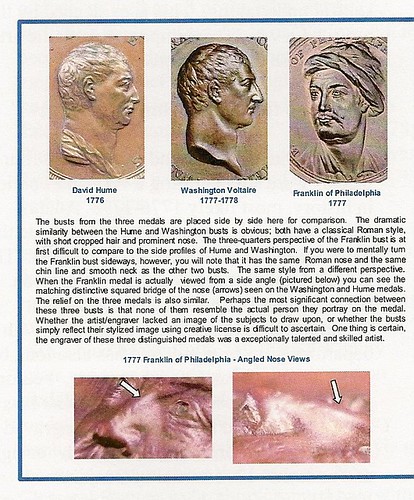
MORE LORE ON ANNIE OAKLEY
Regarding the coin shot through by sharpshooter Annie Oakley, Harry Waterson writes:MUSEUM/COLLECTOR DEBATE: FRANK STEWART'S FIRST U.S. MINT COLLECTION
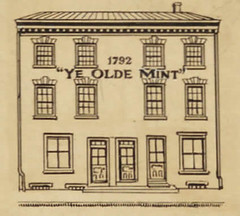 Ron Guth writes:
Ron Guth writes:
Stewart, as I recall, donated the collection to the city of Philadelphia after obtaining assurances that the collection would be on permanent display. Apparently, someone in the city forgot or ignored that promise after he died. I doubt that Stewart would have made the donation had he known that, decades down the road, his collection would disappear from public view.
Len Augsburger and Joel Orosz have already visited the collection. The illustration is a proto-sketch of "Ye Olde Mint" from the Stewart Collection at Rowan University, which the pair used to illustrate their March 12, 2008 Groves Forum Lecture at the American Numismatic Society titled “Frank H. Stewart, Master of the Mint”.
The collection contains over 15,000 books and pamphlets, 5,000 documents and manuscripts, photocopies, 500 West Jersey deeds, maps, newspapers, and periodicals. Emphases are South Jersey history, the Revolutionary War period, Quaker history, the Old United States Mint, and Native American lore. Significant source materials include: letters, diaries, deeds, slavery documents, legal papers, business records, handwritten archives, and military records.
For more information, see: The Frank H. Stewart Room at Rowan University (http://www.rowan.edu/library/policies_services/
special_collections/stewart.htm)
PETE SMITH ON LIBRARY DISASTER RECOVERY
Floods have recently hit the Mississippi River and tributaries. These flood waters include mud, raw sewage, petroleum products, agricultural chemicals and whatever else is released into the flood. Any library inundated with river water will probably discard any damaged volumes and replace them. Cleanup is impossible or too expensive unless a volume is very rare and valuable. Just handling the wet, polluted and moldy books can be a hazard.
Clear water flooding may occur from broken pipes, leaking roofs, open windows or overflowing appliances. Some damage is immediate and irreversible. Books or documents with water damage may develop mold within a couple of days. The solution is to freeze these items as quickly as possible.
In some cases freeze drying may be possible. The documents should be stored with good air circulation and low humidity. You can’t just put them on a pallet with shrink wrap. Books should be on open racks so air can circulate around all sides. This takes equipment that is not available to most amateurs. Freeze drying alone is usually not enough. Freezing buys time for more aggressive techniques.
Books or documents may be washed in clean water. Book pages are gently separated and absorbent sheets inserted between the pages. Books may be pressed to keep the pages flat. This requires time and labor and becomes expensive. Professional restoration may be more expensive than replacement.
What can an amateur do? Freezing will probably do no damage and give you time. Absorbent sheets and pressing may help. Once pages are damp rather than wet, books can be put in sunlight with good air circulation. These processes require time and patience. Readers of the E-Sylum may be interested in a large record center disaster that happened in Minnesota while I was working in the field. This happened in a large off-site private records center with several clients. A fork lift driver dented the steel leg that supported shelves about thirty feet high. Several hours later the leg failed and pulled down the entire section of shelves. Rows of shelves fell like dominoes until the entire room was a pile of rubble. On one end the files broke through the wall and damaged a million dollars of printing equipment in the next room.
In theory, no page was lost or destroyed. However, medical records and x-ray films from broken boxes were mixed with records from other clients. What happens when confidential medical records get mixed with confidential legal files from another client? The company I worked for was brought in to try to sort things out (although I was not on this project). The company that ran the records center did not survive. The liability they incurred far exceeded their insurance coverage.
The same kind of disaster could affect a coin collection or numismatic library. What if all your books and periodicals were dumped in a single pile? What if a coin collection was taken out of envelopes with everything dumped into one box? Collectors can lose sleep thinking about ways this could happen.
ARTISTS & AUTHORS ALLEY TO DEBUT AT BALTIMORE ANA CONVENTION
Located within Artists & Authors Alley, Collector's Corner will feature book and artwork signings, demonstrations, and informal discussions with some of the top experts in numismatics.
Thursday, July 31
10-11 a.m. – Weimar White, chemist, coin conservation expert and author of Coin Chemistry
11 a.m.-noon – Roger Burdette, author, Renaissance of American Coinage, 1905-1921
2-3 p.m. – Barbara Gregory, editor-in-chief, The Numismatist
4:30-5:00 p.m. – Jeff Ambio, author, Collecting & Investing Strategies for Walking Liberty Half Dollars
Friday, Aug. 1
10-11 a.m. – Daniel Frank Sedwick, author, The Practical Book of Cobs
Noon-1 p.m. – David Lange, author of several books and coin board expert
3-4 p.m. – Ron Benice, author of Florida Paper Money: An Illustrated History, 1817-1934
Saturday, Aug. 2
11 a.m.-noon – Kenneth Bressett, editor, The Official Red Book: A Guide to United States Coins
1-3 p.m. – Beth Deisher, editor of Coin World magazine and author of Making the Grade: A Guide to the Top 50 Most Widely Collected U.S. Coins
ANA SETTLES LAWSUIT AGAINST FORMER EMPLOYEES
We generally steer clear of club politics, but did make a point of endorsing a number of E-Sylum regulars who ran for the ANA Board of Governors in the last election. That election swept away most of the old guard and led to the removal of the Executive Director responsible for this vindictive suit, which has drained precious resources from both the defendants and the association.
The press release explicitly apologizes to the defendants. I've never met the new Executive Director Larry Shepherd, but I congratulate him and the Board for handling the matter with dignity.
John Nebel and his fellow defendants also handled the situation as gracefully as possible given the unfortunate circumstances. John is an enthusiastic and tireless volunteer for the hobby, and he managed to maintain his positive outlook on both numismatics and the ANA as an organization despite the lawsuit's tremendous personal and financial toll. His words, quoted below, show a remarkable capacity for commitment to the higher good. Better men than I might have been quickly embittered by the situation.
Throughout it all John continued to offer his time and services to the Numismatic Bibliomania Society and other ANA member clubs by providing free web site hosting services. In the case of NBS he also volunteered his time and expertise to help keep The E-Sylum web site and archive running smoothly (with over 6,000 individual E-Sylum articles, and now the new HTML format with graphics). Thanks, John, and good luck to you, Susie, Larry and Wayne.
Below is an excerpt from the ANA's Tuesday, July 10 press release. -Editor
The resolution followed several meetings between the ANA and John Nebel in which the ANA agreed to dismiss all claims against Nebel, Nulty, Lee and Abraham. The litigation started in July, 2005 when Christopher Cipoletti and the ANA filed suit against Nebel, Nulty, Lee, Abraham and Nebel’s corporation, Computer Systems Design Company.
The case was scheduled for trial in September, 2007, but was rescheduled to August 14, 2008 after the ANA’s former legal firm withdrew from the case in August 2007. Since that date the parties engaged in continued discussions in an effort to resolve their differences.
The ANA Board of Governors voted unanimously to dismiss all claims against Nebel, Nulty, Abraham and Lee and therefore put an end this litigation. As part of the settlement, the ANA made a payment to offset a portion of the defendants litigation costs.
The ANA and the Defendants prefer to engage in numismatics, not litigation. The ANA wishes to extend its sincere apology to the defendants for the hardship that this litigation has caused.
THE DARWIN-WALLACE MEDAL
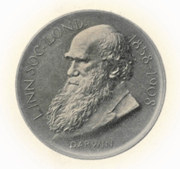

The Darwin-Wallace Medal was awarded in 1908 and again in 1958 to commemorate the 50th and 100th anniversaries of the reading of the joint paper by Charles Darwin and Alfred Russel Wallace "On the Tendency of Species to form Varieties; and the Perpetuation of Varieties and Species by Natural Means of Selection", which was read on 1st July 1858, and published by the Linnean Society.
The Medal has a profile of Darwin on the obverse and a full-face image of Wallace on the reverse, with the marginal inscription “LINN. SOC. LOND. 1858 – 1908” on both sides. It will be awarded again in 2008 to commemorate the 150th anniversary of the reading of the Darwin-Wallace papers.
For more information on the medal, see: The Darwin-Wallace Medal (http://www.linnean.org/index.php?id=344)
In recognition of the continuing importance of research on evolutionary biology, the Society has also announced that it will now award the medal annually from May 2009.
CHINA DITCHES MAO TO PUT OLYMPICS ON NEW BANKNOTE
 The Great Helmsman will be replaced on the six
million new notes by the National Stadium, or Bird's Nest, which is more
in keeping with the image of progress and prosperity that China is trying
to show as the Games approach.
The Great Helmsman will be replaced on the six
million new notes by the National Stadium, or Bird's Nest, which is more
in keeping with the image of progress and prosperity that China is trying
to show as the Games approach.Despite the ravages of the Cultural Revolution and the disastrous social agricultural reform known as the Great Leap Forward, Mao is still an icon in China, considered by the Communist Party to be "70 per cent good, 30 per cent bad". His portrait still gazes out over Tiananmen Square in central Beijing.
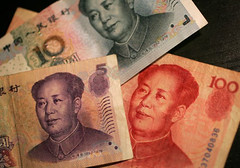 During Mao's rule from the 1949 revolution that
swept the Communists to power until his death in 1976, banknotes featured
more traditional socialist realist fare – determined workers, muscled
farmers, and clear evidence of China's successful modernisation such as
factories or rustic classical scenes.
During Mao's rule from the 1949 revolution that
swept the Communists to power until his death in 1976, banknotes featured
more traditional socialist realist fare – determined workers, muscled
farmers, and clear evidence of China's successful modernisation such as
factories or rustic classical scenes.He first appeared on the banknote in 1990, alongside three other iconic leaders, and his face still adorns all modern banknotes in China.
To read the complete article, see: China ditches Mao to put Olympics on new banknote (http://www.independent.co.uk/news/world/asia/
china-ditches-mao-to-put-olympics-on-new-banknote-862063.html)
WAYNE'S NUMISMATIC DIARY, JULY 13, 2008
Tuesday evening was the meeting of my numismatic social club, Nummis Nova. We met at an Italian restaurant in Springfield, VA. Mike Packard was our host, and he picked "New uses for old coins" as the topic for the evening. I was at a loss and had nothing to bring, although later I realized that counterstamps would fit the bill.Tom Kays came through as usual with a fascinating array of interesting altered coins, including a contemporary counterfeit $20 gold piece that had been cut down for use as a spur. Many of the pieces he displayed were Love Tokens - see below for more information and images.
Other attendees included Joe Levine, Chris Neuzil, Dave Schenkman, Roger Burdette, Wayne Herndon, Julian Leidman and Bill Eckberg. Conversation topics included the recent American Numismatic Association Summer Seminar (where Dave Schenkman taught the Civil War Numismatics class with Wendell Wolka), and the settlement of the ANA's lawsuit against former employees. Joe Levine discussed the funeral and wake of Neil McNeil, and asked whatever became of former ANA Numismatist Editor N. Neil Harris (does anybody know?).
After the meeting I asked Tom Kays if he could send us images of some of the love tokens he displayed, and these are shown below. Tom writes:
1) 1662 English Crown of Charles II with engraved “dispatch” on the obverse, in this case what is likely a ship's death medal for “Polly Buller – Age 9 years – July 14, 1778” and also the name “J Birks”.

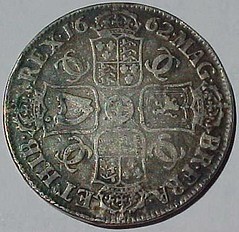
2) English or Irish half penny with engraved “match” on both sides, a fanciful balloon and “Richard Clift – Amelia Spectal 1787.” May their love ascend aloft to the heavens as dainty as a hot air balloon.
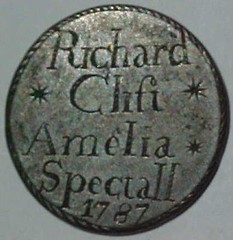
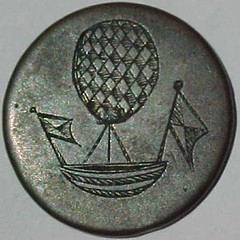
3) English half penny of George I with script initials in a cartouche “JB” and “1812”. This may be a remembrance of a “snatch” or leave taking for some extended time. Prisoners sentenced to transportation to faraway places like Virginia or Botany Bay sometimes left low denomination love tokens made in gaol while awaiting transport, as remembrances, having had lots of time to kill

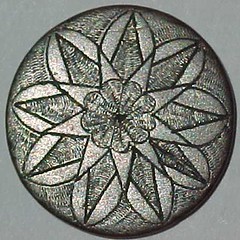
4) 1871 US Quarter Dollar with deep engraving in the style of a Pennsylvania Hex sign. Julian quipped that this was no way to treat a “CC” quarter as he could see some indication of the mint mark. He made me look!
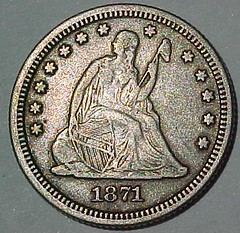
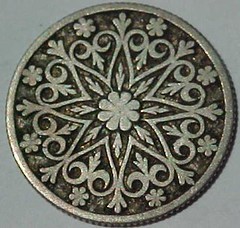
On Friday my family and I made a trip to Baltimore with visiting relatives. Baltimore being the site of the upcoming ANA convention, you could consider it a numismatic scouting trip. If you're looking for coins outside of the convention hall, here's a hint: take the walkway across the street from the Inner Harbor mall to The Gallery mall. Along the wall is a nice display of early artifacts, and the exhibit includes some coins.
The Inner Harbor area of Baltimore was as lovely as always, with quite a bit of sights and activities for visitors. We took the "duck" tour on an amphibious vehicle, first driving around town then boating around the harbor. One sight is the U.S. Coast Guard Cutter Taney, which is docked in the harbor and available for tours. The Taney and its crew were the first to engage Japanese attackers at Pearl Harbor in 1941.
I thought it interesting to be passing the last surviving ship from the start of the U.S. involvement in World War II while floating by on a vessel built for service on D-Day, the beginning of the end of the war in Europe. The "duck" vehicles now serving to ferry happy tourists were built to ferry troops to Omaha Beach in the Invasion of Normandy. Many of those troops didn't live til lunchtime on June 6, 1944, and here we were on one of those boats blowing duckbill-shaped quacking noisemakers. I just couldn't get fully in the mood to party, but my family had fun. But I guess that's what freedom's all about, though.
On Sunday we made another excursion, this time to Washington, D.C. It was just my wife and I and our three kids. We drove past the Lincoln, Washington and Jefferson Memorials, then found parking in a garage near the National Archives. The National Museum of American History, where the National Numismatic Collection was displayed for years was still closed for renovations.
We went to the National Museum of Natural History. On the first floor I spotted a large piece of Yap Stone money along with an Easter Island statue. We visited the dinosaur and mineral halls, making sure to see the Hope Diamond.
Afterwards we walked through the nearby National Sculpture Garden, then down the street to catch views of the Capitol rotunda and Washington Monument. We almost went into the National Archives, but with a 45+ minute wait and three tired kids, we just headed home to Virginia. On the way out we caught a view of the White House. Washington D.C. never ceases to fascinate me - it's well worth a side trip following the ANA convention in Baltimore.
AUSTRALIAN COIN COLLECTION OF DR JOHN CHAPMAN TO BE SOLD
 One of the most important private collections
of Australian historical coins and medals is about to go under the hammer
in Melbourne.
One of the most important private collections
of Australian historical coins and medals is about to go under the hammer
in Melbourne. The collection belongs to 80-year-old retired dentist Dr John Chapman, and includes what's claimed to be the first piece of Australian colonial art, the Charlotte Medal.
It was handcrafted by a convict while his ship, the Charlotte, sank at anchor in Botany Bay in January, 1788.
"It's really intimate records of early Australian history. Little records enclosed in metal, really," Dr Chapman says.
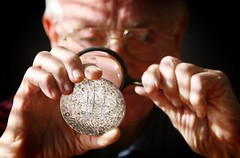 These so-called little records are actually some
of the most important pieces of Australian Colonial art, and its shining
glory is the spectacular Charlotte Medal.
These so-called little records are actually some
of the most important pieces of Australian Colonial art, and its shining
glory is the spectacular Charlotte Medal."It's the most wonderful piece I own, because apart from being a medal, it's the first piece of colonial art that exists," he said.
Fashioned from a metal kidney dish while the Charlotte sat at anchor with the First Fleet at Botany Bay in January, 1788, this gleaming metal disk predates white settlement, the work of an expert engraver and notorious forger, the convict Thomas Barrett.
Also opened to the highest bidder is a rare 1813 holy dollar.
"It is the first Australian coin - or the first coin produced in Australia. Most of them were eventually melted down," Mr Sharples said.
It was also the piece that gave Dr Chapman the collecting bug back in the 1960s.
"I knew nothing about numismatics or medals or coins or anything, but I wanted a holy dollar, and I saw one advertised by a dealer in Port Phillip arcade," he said.
"So I raced in there and I said, 'You're selling the holy dollar?' 'Yes,' [he said]. I said, 'I want the best one', and he brought them out. I said, 'Right, I'll have those'."
Mr Sharples said the purchase, seemingly out of the blue, is stuff of collector legend.
To read the complete article (and view a great video), see: Collector's 700 'little records' to go to auction (http://www.abc.net.au/news/stories/2008/07/11/2300747.htm)
To read a related article, see: Expert in fakes sells the final work of the First Fleet's great larrikin forger (http://www.theage.com.au/national/expert-in-fakes-sells
-the-final-work-of-the-first-fleets-great-larrikin-forger-20080705-32ah.html?page=-1)
LORD ASHCROFT'S VICTORIA CROSS COLLECTION GOES TO IMPERIAL WAR MUSEUM
The 152 medals, which range from the Crimean to the Falklands wars, will be displayed alongside the 50 VCs and 29 George Crosses (GCs) already held by the Museum.

The gallery, which will be named after Lord Ashcroft, will examine the creation of the VC and the George Cross and the personal stories behind the award of the medals.
Lord Ashcroft bought his first VC at auction in 1986 – the medal awarded to Leading Seaman James Magennis, one of two crew serving in a midget submarine that planted limpet mines on a moored Japanese cruiser at the end of the Second World War.
The trust he set up to care for and protect the medals now owns more than one tenth of all the VCs ever awarded.
Lord Ashcroft is the author of Victoria Cross Heroes, published in 2006 to mark the 150th anniversary of the creation of the VC by Queen Victoria through a Royal Warrant. The foreword was written by the Prince of Wales.
To read the complete article, see: World's largest VC collection to go on show (http://www.telegraph.co.uk/news/uknews/2270310/
World's-largest-VC-collection-to-go-on-show.html )
CANADIAN DEATH RACE COINS
Entrants from as far away as Australia will take part in the ninth incarnation of The North Face Canadian Death Race on Aug. 2 and 3 in Grande Cache, a Rocky Mountains foothills town about 400 kilometres northwest of Edmonton. It's a test of physical and mental endurance that has become an annual challenge for elite athletes and weekend warriors.
The Death Race plays on the Greek myth of Charon, the ferryman who ushered the souls of the dead across the river Styx and into Hades for a fee of one gold coin per soul.
Each of the 1,000 or so entrants will receive a specially minted coin they must take with them as they make their way through the rugged mountain terrain surrounding Grande Cache.
Racers must have their coin to cross the Smoky River near the end of their trek. Losing the coin means instant disqualification.

To read the complete article, see: Death Race brings brave souls to Alberta (http://www.canada.com/calgaryherald/news/story.html?id=1ffe9b87-efcd-4307-ae6e-9e695bb8ecd9)
BUTTONS: THE NUMBER THREE COLLECTING HOBBY
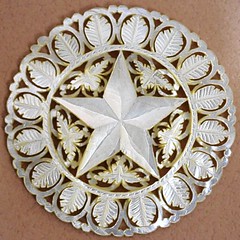 Like many other items that people collect,
buttons are prized for the materials they are made of, their rarity, age,
condition and where they were made.
Like many other items that people collect,
buttons are prized for the materials they are made of, their rarity, age,
condition and where they were made."An attractive thing about buttons is that they have been made from just about every material that is out there," Mrs. Fischer said. "If it is stable enough, they will use it."
Buttons have been made from bone, glass, brass, silver and plastic. Some of the more intricate ones have been carved from mother of pearl. Collector Faith Strobel, of Winfield, has a button decorated with peacock feathers.
"One of the fascinating things about button collecting is that your collection is never complete," Mrs. Tutelo said. "There is always something different, something to add."
To read the complete article, see: These collectors are right on the button (http://www.post-gazette.com/pg/08195/896239-54.stm)
SURVIVALIST URGES STOCKPILING OF NICKELS
His reason is the same as everyone else's - he believes they are going to be worth more than face value in the future than present value, or the melt value of the coins' metal composition today. It is a way survivalists can earn a substantial return on an easy investment.
The author is James Wesley, Rawles (he sticks a comma after his second name in everything he writes!) He shuns pennies (cents, that is). A ton of cents is too heavy and takes up too much space. Instead Mr. Wesley Comma Rawles recommends socking away nickels.
He even suggests stockpiling these in rolls, stored in surplus metal ammunition boxes - they just fit. Don't use cardboard boxes - too flimsy, won't stack. He even suggests how to acquire large number of nickel rolls.
But don't put more than 5% of your total investment in nickels. As a survivalist he still sticks to his primarily recommendations of beans, bullets and Band-Aids.
To read his blog on nickels, see: Mass Inflation Ahead -- Save Your Nickels! (http://www.survivalblog.com/nickels.html)
INDIANA BANK RETURNS $1,000 BILLS TO DEPOSITOR
The crisp bills with the image of President Grover Cleveland weren't fakes. It turns out they're rare 1934 bills worth far more than their $1,000 face value.
American Savings Bank president Michael Mellon says they were just looking out for a customer when they returned the bills.
A rare coin dealer says the bills could be worth up to $4,500 each.

The woman was not identified for security reasons. She told Mellon the bills came from a relative a long time ago and she had no idea what possessed her to bring them into the bank yesterday.
To read the complete article, see: Indiana bank returns rare $1,000 bills to customer (http://www.wdtn.com/Global/story.asp?S=8654205)
DENVER COIN DROP CIRCULATES CENTURY-OLD COINS
To do it, he's circulating 465 pennies and nickels minted 100 years ago, when Denver held its first convention.
"There's so much panic," he said. "Hopefully, this helps them get in the mood of it all."
Grueskin, an attorney at Isaacson Rosenbaum PC, gave 8 cents to each of his co-workers on Thursday.
There's a catch: They must spend it at a building that was around in 1908. Or they can use it on items that someone would have purchased 100 years ago.
Grueskin said that by doing this, they're going back in history.
"Imagine that you just got off the train in Denver" for the 1908 convention, he said to his co-workers. "Imagine what you would need."
Spend it on coffee, he said, but not on a Starbucks double latte with whipped cream and sprinkles. Spend it on shoelaces, he said, but not flip-flops.
"You have to stretch the brain a lot to think about what they would've done in 1908," Tumey said. "You have to think about what we have now and what they had then."
Tumey said she plans to spend the rest of her money at the Molly Brown House Museum or at the Tattered Cover Book Store.
"It's just fun," she said. "It's in the spirit of the convention. It's exciting doing this in the city that's hosting the convention."
To read the complete article, see: Old currency coins new mood for change (http://www.denverpost.com/dnc/ci_9781175)
ULTIMATE COIN DROP: HOUSE VISITOR SPENDS COINS WORTH $500,000+
Robert Williams, 43, who buys and sells rare coins for his private collection, told Los Angeles authorities that a family friend visiting from Argentina did not understand that coins he had left in his office were collectible and hence exchanged them for three one dollar bills.
The coins included two 1969-S Lincoln Cents with a Doubled Die Obverse, each worth roughly $25,000.
Williams said his entire family retraced the steps of their Argentinean visitor, including purchases made at a nearby supermarket and fast food restaurant, but were only able to recover four of the valuable quarters, dimes, nickels and pennies.
The coin collector said all of the coins were insured against theft or damage, but it is still unclear whether spending them accidentally constitutes a recoverable loss.
"Our friend is heartsick knowing that he purchased groceries and lunch that ended up costing us more than one-half million dollars," Williams said. "Truthfully, it was irresponsible of me to leave coins of such a high value out of their cases and in open view. I blame only myself."
The Williams family spent six hours going through coin bags at the supermarket where their friend had shopped and did recover four of the missing coins. "Searching for them was nasty and really was like searching for a needle in a haystack," he said. "I'm surprised we recovered any."
Williams said he plans to post a full list of the missing coins and to offer a reward for any that turn up. He acknowledged that the longer they stay in general circulation, the less likely they will turn up and the more likely their condition will be compromised.
"There is no telling where these coins might be by now," Williams said. "You probably have a better chance of winning the lottery than recovering one of these coins."
To read the complete article, see: 18 Rare Coins Mistakenly Returned to General Circulation - Value $600,000 (http://hopelessutopian.com/2008/06/19/18-rare-coins-mistakenly-returned-to-general-circulation.aspx)
DAVID GANZ ON REP. BROOKE'S ROLE IN THE BICENTENNIAL COIN PROGRAM
He will join the ranks of about 185 other men and women with this coveted award.
Now 89 years old and living in Miami, with reported land holdings in Saint Marten, Brooke has had a life of firsts that Rep. Niki Tsongas recently recited: “the first African American elected to the United States Senate by popular vote. I am proud that he accomplished this feat in my home state of Massachusetts, which he represented from January 1967 until January 1979.”
There’s a major numismatic component to Brooke’s Senate tenure, one that has affected commemorative coins ever since. It’s worth retelling, even as the nation readies to honor him with an award first given to George Washington in 1776. It has to do with Bicentennial coinage and the silver-clad component.
First, some background.
The importance: from the Bicentennial coin program has flowed all modern American commemorative coinage. In the absence of the 1973 approval, it is highly unlikely that, by 1981, the Treasury would have endorsed the George Washington commemorative half dollar. It is even less likely that the state quarter program would ever have become reality.
That in turn cascades to the Lewis and Clark nickels, the Presidential dollar coin program of 2007, the Lincoln cent design changes of 2009 and programs not yet authorized but somewhere past the drawing board.
Lessons learned from Bicentennial coin sales have become part of the legislative process and, ultimately, enshrined in the current silver proof coin program that augments the regular proof set program that the Mint has promoted since 1950.
When Treasury Secretary Shultz signed off on the transmittal letter in March 1973, no one could have predicted the eventual result.
Brooke introduced an amendment that succeeded in authorizing the striking of 45 million silver-clad Bicentennial coins, intended for collectors. Another 15 million could be produced if there was sufficient demand. (Brooke did this for a business constituent of Massachusetts, who made the cladding).
From the Bicentennial coin program, the Mint learned some truisms about the marketing of modern commemorative coins, which differ substantially from selling mint sets and proof sets, previously their dominant sales product.
Ed Brooke’s legacy casts a giant shadow, and his other accomplishments merit the gold medal.
To read the complete article, see: Gold medal deserved for numismatic role (http://www.numismaticnews.net/Default.aspx
?tabid=459&articleid=11197&articlemid=1391#1391Articles)
HUB COIN BLOOPER: TYPO, OR MEHL'S ADVERTISING SECRET?
John Lupia writes: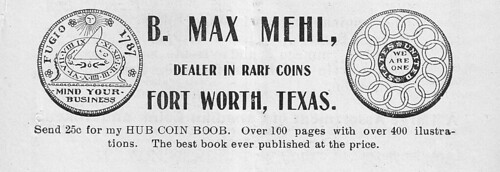
FEATURED WEB SITE: CHALLENGE COIN ASSOCIATION
This week's featured web site is recommended by Joseph D. McCarthy, who writes:From the web site:
http://www.challengecoinassociation.org/
